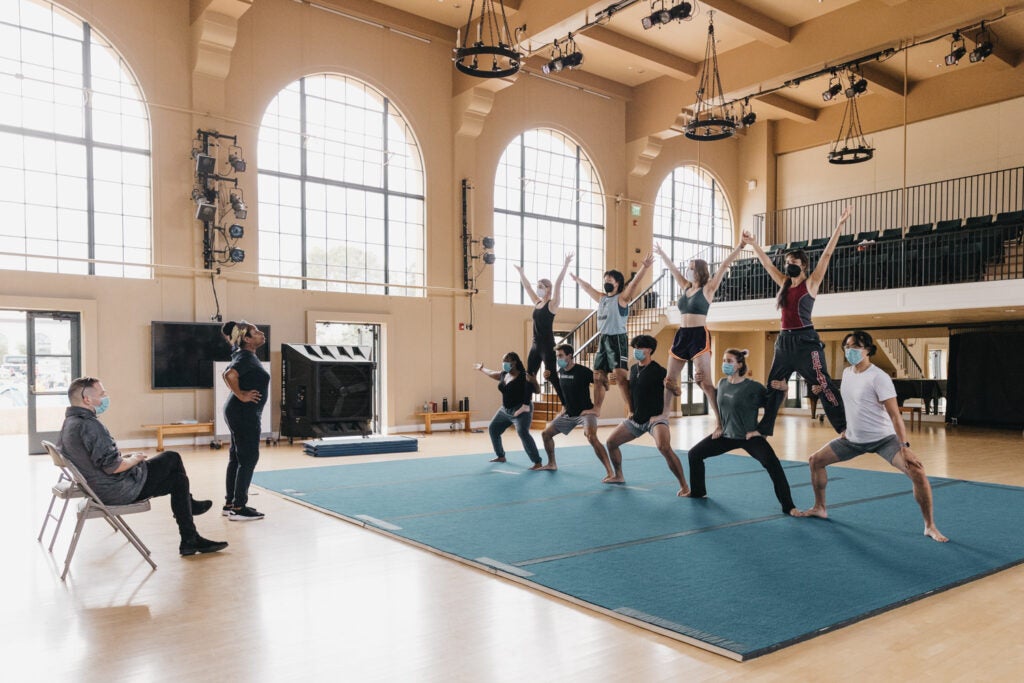Australian circus comes to Memorial Auditorium
Stanford undergrads join the cast of Leviathan, a production by the Australian circus company Circa, in two performances at Memorial Auditorium.
Stanford Live’s upcoming North American premiere of Leviathan (Sept. 30 and Oct. 1) from the acclaimed Australian circus company Circa asks both performers and spectators to reflect on the disconnect and interdependence that have characterized the public experience of the pandemic. Conceived by Circa Artistic Director Yaron Lifschitz, the show is a thoughtful international and intergenerational collaboration that honors the history of circus artistry in the San Francisco Bay Area.

Arts Intensive students rehearse for Leviathan with Aleta Hayes in Roble Gym. (Image credit: Andrew Brodhead)
In addition to Circa’s Australian performers, the 36-member cast includes Bay Area youth performers and Stanford undergraduates enrolled in the Art of Circus Movement Arts Intensive course, as well as local movement artists. The result is a breathtaking performance with elements of contemporary circus and dance that brings segments of the Bay Area population together in a testament to the value of interdependence and collaboration.
Kinetic connection
As performers hang from a grid suspended in the air and tumble, balance, and soar across the stage together, the dynamic choreography, moments of improvisation, and theatrical lighting create a sense of bustling collaboration.
“Teaching, mentoring, and witnessing the students grow in this Arts Intensive has been exciting and enriching on so many levels,” says Aleta Hayes, Stanford Theater and Performance Studies (TAPS) lecturer and choreographer, who teaches the course. “It was interdisciplinary, collaborative, and boundary-pushing working with the Theater and Performance Studies Department, Stanford Live, Stanford Arts Intensive, and visiting troupe Circa. I also grew as an artist and educator thinking about what circus has been and will be for the future of performance.”
For the first weeks of rehearsals, which began earlier this month, the youth cast practiced at EPACENTER, the new community arts center in East Palo Alto. Stanford Live and EPACENTER had long hoped to build a new partnership and are excited to launch the collaboration through the Circa residency. Full cast rehearsals later moved to the Stanford campus, with the Circa ensemble joining the youth cast, local adult performers, and Stanford undergraduates. The two performances will be in Stanford’s Memorial Auditorium.
“It’s been a joy to work together with so many members of the community in such a direct and visceral way,” said Matthew Chapman, TAPS circus arts instructor and member of Leviathan’s local adult cast. “The Circa artists have been so welcoming and have done a fantastic job bringing us into the project.”
Stanford Arts Intensive student Sasha Sokolova recalls learning how to lift another person during the first week of training. “I would never have imagined that my body is capable of something like that; I thought, ‘this requires a lot of trust, this is very intimate.’ Ultimately, this whole training and performance were just about that: human connection, building things together, trusting, pushing the limits of our bodies and minds.”
Collaboration is a vital safety mechanism when creating a circus production at this scale. “Circus is actual. It’s dangerous. It’s real. And it’s there. It’s an existential encounter with that moment and those people. Your safety and your success rely on everyone, together, and the audience feels that sense of jeopardy,” Lifschitz said.
The underlying message is that our attachment to individualism shifts drastically as soon as we are responsible for one another’s physical safety. Though audience members may not be on stage with Circa to feel this twinning of danger and trust directly, Lifschitz believes that the space of the theater creates an intimate shared communion between performers and spectators, extending the deeply embodied entanglement from the stage into the audience so that we, too, feel the thrill of the jeopardy and the bravery of connection.
This story was originally written for Stanford Live Magazine and has been adapted for Stanford Report. Read the full version online at live.stanford.edu/magazine.